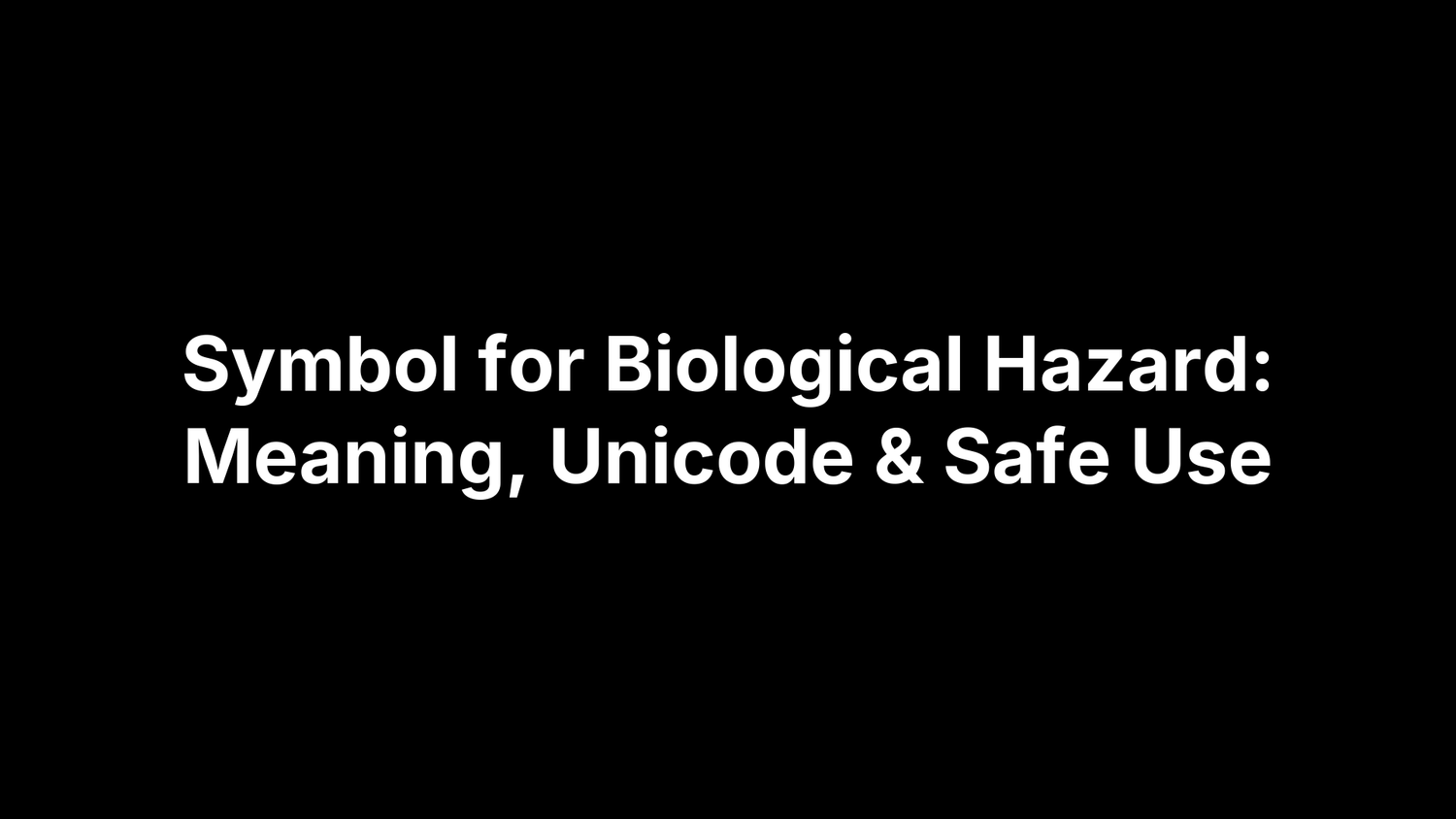Symbol for Biological Hazard: Meaning, Unicode & Safe Use
☣ — that three-pronged icon means “biohazard,” and it’s the single, globally accepted signal that a material can infect, sicken, or otherwise harm living organisms. Whether it’s stenciled on a sharps container, printed on a blood sample bag, or embedded in an electronic medical record, this symbol tells everyone to treat the contents with extra caution.
But copying and pasting the character isn’t enough. A biohazard label that’s the wrong shade of orange-red, rotated a few degrees, or typed without accessible alt text can fail OSHA inspections, stall shipments, or confuse the very people it’s meant to protect. The guide that follows explains exactly how to get it right—from the 1966 Dow Chemical design brief to the official Unicode code point (U+2623), size and color rules, transport regulations, and placement tips. By the end, you’ll know how to display ☣ with confidence and keep your team compliant and safe.
Origins and Development of the Biohazard Symbol
Before the emblem appeared on every red bag and laboratory door, it started as a design problem: labs needed one unmistakable warning that anyone—doctor, janitor, or delivery driver—could identify at a glance and remember hours later.
Pre-1960s hazard symbols and their limitations
Until the mid-1960s, infectious materials were marked with skull-and-crossbones, all-caps text, or ad-hoc lightning bolts. Dow researchers surveyed hospital staff and discovered that barely 6 % could recall those markings after a single shift; many confused them with toxins or radiation. The inconsistency bred labeling gaps and needless exposures.
Design process at Dow Chemical (1966)
Industrial hygienist Charles Baldwin led a Dow Chemical team that sketched 24 candidate icons. Their criteria: instantly memorable, unique, meaningless until taught, symmetrical for easy stencil cutting, and legible when smudged. Public recall tests whittled the field to the now-familiar three interlocking crescents around a circle—identified by 97 % of participants after one brief viewing.
Global standardization and timeline of adoption
The National Institutes of Health adopted the new icon in 1967, followed quickly by the CDC and World Health Organization. It entered ANSI Z535 safety standards in the 1970s, became ISO 7010 symbol W009 in 1990, and is now mandated in biosafety regulations on every continent.
Visual Anatomy and Official Specifications
The biohazard emblem is more engineering drawing than logo. Its dimensions, angles, and colors are locked down in international specs so the message stays unmistakable at any size. Nail the details below and your labels will satisfy ISO, ANSI, and OSHA eyes.
Geometric structure: three crescents and a central ring
Picture a circle. Cut it into thirds and draw a moon-shaped blade in each sector; leave equal gaps between blades. The finished mark has 120° rotational symmetry and reads the same from every angle.
Key ratios
- Overall diameter (D) = 1
- Central ring = 0.6 D
- Crescent outer radius ≈ 0.95 D; inner radius ≈ 0.75 D
- Stroke width = 0.05 D
Because the outer strokes drop slightly below the centerline, the icon appears to “anchor” itself visually—a deliberate tweak that prevents confusion with radiation or recycling symbols.
Color standards: fluorescent orange-red background
OSHA calls for a fluorescent orange-red field with the symbol and the word “BIOHAZARD” printed in black. Close matches:
| System | Reference |
|---|---|
| Pantone | 165 C |
| RAL | 2005 |
| HEX | #FF4F00 |
When reversing for dark packaging, use a white symbol on solid black—but keep all other proportions intact.
Permitted and prohibited variations
| Variation | Status | Note |
|---|---|---|
| Solid black symbol on orange-red | ✔ | Default print spec |
| White symbol on black (reverse print) | ✔ | Allowed for transport labels |
| Outline-only version | ✔ | For tiny glassware |
| Any gradient, emoji, or 3-D effect | ✖ | Non-compliant |
| Rotated or mirrored icon | ✖ | Non-compliant |
If your artwork isn’t in the first three rows, update it before the inspector arrives.
Unicode and Digital Encoding
The biohazard symbol isn’t just stencil art—it lives in PDFs, websites, and mobile apps, so getting its digital encoding right is critical. The good news: Unicode has already reserved a single code point for it, which means it can be rendered consistently across operating systems, fonts permitting. The bad news: if you rely only on the raw glyph, a missing font or lack of alt text can leave users staring at an empty box. The tips below keep the ☣ icon intact and accessible.
Unicode code point U+2623 and HTML entities
- Direct character:
☣ - Decimal entity:
☣ - Hex entity:
☣
Copy-and-paste snippet for HTML or Markdown:
<span aria-label="Biohazard symbol">☣</span>
Typing and displaying the symbol on major systems
- Windows: hold
Altand type2623on the numeric keypad, or pick it from Character Map. - macOS:
Ctrl + Cmd + Space, search “biohazard,” press Return. - Linux (GTK):
Ctrl + Shift + u, then2623, hit Space. - iOS / Android: open emoji keyboard and enter “biohazard” in the search bar.
Embed the icon in a vector-based font (Noto, Segoe UI Emoji) or supply an SVG fallback to guarantee crisp scaling.
Accessibility and readability online
Screen-reader users can’t interpret lone symbols. Always pair the glyph with alt text such as alt="Biohazard symbol" or an aria-label. For legacy systems that miss the character, provide a text fallback (“BIOHAZARD”) or an inline SVG image. Regularly test pages with font substitution disabled to confirm the warning still shows up.
Regulatory Requirements You Must Know
Putting the ☣ icon on a label is not optional; it is dictated by federal and international regulations. A wrong color swatch or undersized print can trigger five-figure fines, rejected freight, or lab shutdowns. The three frameworks below cover most situations that Safety Managers, Lab Directors, and Logistics teams encounter.
OSHA Bloodborne Pathogens Standard (29 CFR 1910.1030)
OSHA demands the biohazard symbol whenever blood or “other potentially infectious materials” are present. Typical touchpoints:
- Red bags and rigid waste containers
- Refrigerators, freezers, and centrifuges storing human specimens
- Sharps disposal units and reusable tools awaiting decon
Specifications: black ☣ plus the word “BIOHAZARD” on a fluorescent orange-red background; legend readable from 3 ft. Each mislabeled item can draw a penalty exceeding $14 000.
CDC/NIH Biosafety guidelines for BSL-rated labs
The BMBL manual requires a door placard for any BSL-2, ‑3, or ‑4 space. Minimum content:
- Biosafety level and agent names
- Required PPE and entry procedures
- Two emergency contacts with 24 ⁄ 7 numbers
Mount signs at eye level (60–66 in) and update them promptly when agents or procedures change.
Transportation rules: DOT, IATA, UN Class 6.2
When infectious material ships off-site, DOT and IATA rules take over. Key points:
- 50 mm minimum ☣ within the diamond UN 3373 or UN 2814 label
- Duplicate labels on two opposing sides of the outer package
- “INFECTIOUS SUBSTANCE” legend and orientation arrows for Category A
IATA permits a white-on-black reverse print, but all other dimensions mirror OSHA specs. Failing to comply can halt flights and rack up hazmat fines topping $83 000.
Correct Placement and Usage Examples
Choosing the right sticker or stencil is only half the battle; it has to be put where people actually see it and in a format inspectors expect.
Containers, bags, and sharps disposal
- Soft red bio-bags under 10 gal: symbol ≥ 25 mm high, centered on both faces.
- Large bags or rigid pails: diameter ≥ 5 % of the longest side so the mark is still legible when the container bulges.
- Adhesive labels work on reusable bins; single-use bags should be pre-printed so the mark can’t peel off during autoclave or incineration cycles.
Room and equipment signage in labs and hospitals
Door placards belong at eye level—60–66 in from the finished floor—and on the latch side so staff reach for the knob only after reading the warning. Post duplicate decals on biosafety cabinets, centrifuges, and transport carts. Where non-English speakers work, add a second line (“PELIGRO: BIOPELIGRO”) while keeping the icon unaltered.
Waste management and transport packaging
For off-site pickup, apply two identical ☣ labels on opposite sides of the outer box, at least 50 mm each. Seal the red inner bag, close the rigid liner, then affix the shipping documents in a pouch—never over the symbol. Finish with orientation arrows if liquid cultures are inside; carriers reject boxes when the arrows cover or obscure the biohazard mark.
Common Mistakes and Compliance Pitfalls
Even veteran EHS teams stumble on the basics. The missteps below are the ones inspectors note most often—and they’re quick ways to earn citations or have shipments rejected.
Wrong colors or poor contrast
Printing the black ☣ directly on a red bag makes the icon disappear under fluorescent lights. OSHA says high contrast only: black on orange-red, or white on black for transport. Unsure? Snap a phone photo and switch to grayscale; if the symbol fades, so will compliance.
Incorrect size and visibility
A door placard under 7 cm or a tiny sticker wrapped around a test tube neck fails the “read at a glance” test. Follow the minimums—7 cm for walls, 1 cm for vials—and keep labels flat; curved edges distort the crescents.
Using the symbol without risk assessment
Slapping ☣ on every bottle “just in case” is a regulatory no-no. Over-warning dilutes credibility and can violate lab classification rules. Document a biosafety review first, then label only genuine infectious hazards.
Quick Answers to Popular Questions About the ☣ Symbol
Need the fast version? Here are the answers people Google most about the biohazard icon.
What does the ☣ symbol mean in plain language?
Warns that material or area holds infectious agents dangerous to humans or other life.
Is the biohazard symbol copyrighted or free to use?
Public-domain artwork, but its use is governed by OSHA, CDC, and transport codes.
Can I modify the symbol colors to match my brand?
Only on decorative graphics. For real safety labels, stick to black on fluorescent orange-red.
What other biological hazard symbols are used worldwide?
You may also see the UN 3373/UN 2814 Class 6.2 diamond and internal BSL level icons.
Key Takeaways for Safer Biohazard Labeling
- ☣ is the one—and only—symbol for biological hazard. Reproduce it with its three crescents, 120 ° symmetry, and 0.6 D center ring.
- Use black on a fluorescent orange-red field (Pantone 165 C / RAL 2005 / #FF4F00) or, when transport rules allow, white on black. No gradients or “emoji” tweaks.
- Digital use is simple: Unicode
U+2623(HTML☣). Pair the glyph with alt text for accessibility and supply an SVG fallback. - OSHA 1910.1030, CDC/NIH BMBL, and DOT/IATA Class 6.2 each mandate size, color, and placement. Miss one detail and you risk fines, shipment holds, or lab shutdowns.
- Place the icon where eyes naturally land: eye-level door placards, centered bag prints, opposing-side package labels.
- Avoid over-labeling; document a risk assessment before applying the mark.
Need compliant biohazard stickers or custom safety signage fast? The experts at Safety Decals can print, cut, and ship exactly to spec—so your next inspection is a non-event.


